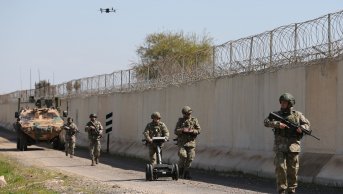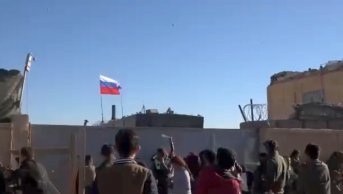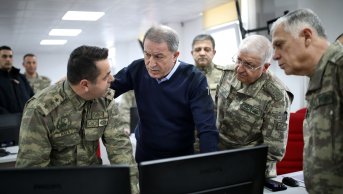The Fight for the Turkmen Mountain in Syria
In line with the increasing efforts for political solution in Syria, the Assad regime backed by Russia and Iran intensified its operations in order to be more powerful at the negotiation table and impose the borders of the controlled areas as the final borders during the negotiations. Assad regime has advanced since the day Russia started supporting the Assad regime via airstrikes. When Russia got involved in the Syrian Civil War, it stressed that it would be involved in favor of Kurds (can be read as PYD/YPG) together with the Assad regime. Since then, PYD/YPG has also proceeded with the support of the US rather than Russia. YPG seized from ISIS the Tishrin Dam, which supplies electricity to much of Northern Syria. In addition, YPG has made few attempts for moving toward Azaz from Afrin. In this area, which has been declared as 'red line' by Turkey, the Russia support to YPG is much more prominent compared to the US support. The news about Russian aerial logistical support to YPG in Afrin has appeared in the press.
The military operations by the Assad regime and its supporters mostly intensified on the rural areas in the north of Latakia and Idlib. When we read these operations together with the YPG attempts at the Azaz-Cerablus line, the strategic objectives of the regime camp concerned can be listed as follows:
- Establishing a regime zone, where p of the Syrian population resides and the access to East Mediterranean is guaranteed, under the protection of Russia,
- Establishing a safe zone in the vicinity of the regime zone,
- Ensuring the total control of the access to Mediterranean from Syria,
- Seizing Idlib and besieging Aleppo,
- Cutting the geographical link of Turkey with Syria.
In terms of the objectives of Russia and the regime, the rural areas in the north of Latakia (Bayır-Bucak), which is intensively populated by Turkmen, comes to the fore. The mountainous areas of Bayır-Bucak have been under the control of Turkmen since July 2012. Since then, the regime forces have occasionally conducted operations to the Bayır region, but they have not been able to proceed on the ground, so they engaged in aerial bombardment. Consequently, 150-200 thousand people, majority of which were Turkmen, living in this region migrated to Turkey. Simultaneously, the armed Turkmen opposition was united under "Turkmen Mountain Division". Later on, in coordination with the Syria Turkmen Assembly, in accordance with the attempts to organize Turkmen military units, the name of the Turkmen Mountain Division is changed into the "2nd Coastal Division" in the first months of 2015. During this time, three armed groups, namely "2nd Coastal Division"(the strongest), Sultan Abdulhamid Brigade, Jabal Al-Islam, which were totally composed of local Turkmen were maintaining the security in the region.
In conformity with the objectives of Russia and the Assad regime, in the third week of November, the ground elements composed of Syrian army, local and foreign pro regime militia groups under the air support of Russia launched an operation to Bayır-Bucak. Although the regime and its allies advanced at the beginning, soon the balance was achieved on the ground. Kızıldağ, which has a strategic importance for controlling the whole region, changed hands several times. However, with the help of intensive airstrikes of Russia, the ground elements of the regime were able to advance and seized Salma in the last weeks. As of now, the control of the Bayır region was seized by the regime (or Russia) except four little Turkmen towns. Since the Assad regime is able to control high hills, it can easily come to a position of seizing these four towns.
This development has brought in several risks for Turkey which has stated several times that it sees the regime, ISIS, and YPG at its borders equally dangerous. This development would cause Turkey to face regime forces as well as the local and foreign militia forces in support of the regime along its Hatay border. Russia can be added to that list of regime supporters after the warplane crisis. The news appeared in the Turkish press about the developments that Russia placed S-400 missiles to the Salma town in the Turkmen Mountain and intercept stations to Gımam and 45 Hill would increase concerns. The fall of the Turkmen Mountain before the political solution efforts will lead the Assad regime and its allies to become more powerful during the negotiations. This will lead the Assad regime and Russia to be more cautious for compromise and weaken the attempts of Turkey to put pressure on the Assad regime. The fall of the Turkmen Mountain is also important in terms of changing the military balance in Idlib and Aleppo against the opposition. Another possibility may be the new waves of migration to Turkey. Following the latest operations, around 10 thousand Syrians came to the Turkish border. As soon as Russia and the regime advance to the Kurd Mountain, 50 thousand Syrians are expected to leave their homes and migrate to Turkey.
Nonetheless, the latest developments may result in the Turkish attention to be directed more on the border area. Three groups may be mentioned to be struggling for the control of Northern Syria. The first one is the regime forces backed by Russia, the second one is the PYD/YPG supported by the US and Russia and the third one is the Syrian opposition backed by Turkey. For all the three groups, ISIS turns out to be the common threat. It is possible that the border line might be cleared from ISIS in a relatively short time, but the main question will be the actor(s) that will fill the vacuum left from ISIS.
What is crucial for Turkey thereafter would be the protection of two regions; the line between Azaz and Jarabulus controlled by the ISIS and the Bayır-Bucak region. Both of these regions are highly populated by the Turkmen. This will further increase the significance of Turkmen for Turkey because of the kinship in a short span of time. In the press release of the meeting held on 27 January 2015 by the Turkish National Security Council, it was stated that "the support for the Syrian Turkmen will continue." This shows that Turkey has a long-term approach toward the struggle for Bayır-Bucak and Aleppo.
Although Russia and the Assad regime approach the struggle for Bayır-Bucak in terms of strengthening their hands before the political solution, the struggle seems to be long-lasting for the Turkmen since the issue is far beyond "countering terrorism" as asserted by the Assad regime or Russia. Despite the Turkmen fight against the regime, from now on, the main question for Turkmen is the usurpation of their land and homes. The likelihood of the Turkmen armed forces to resist against the heavy Russian airstrikes is gradually decreasing. However, even bringing the de facto situation formed by force to the legal ground would not mean anything for the local population. It is fair to say that an unjust peace would not bring permanent stability.












